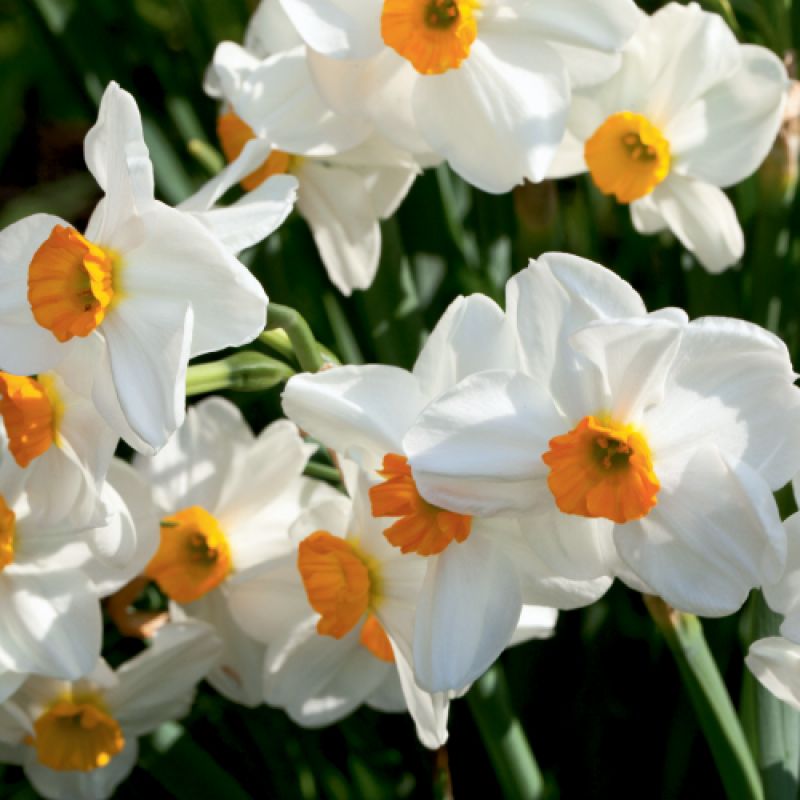
With its bright yellow blossoms, the sunny daffodil is a harbinger of spring; its arrival lets us know warmer weather is just around the corner. And that’s not the only reason this member of the genus Narcissus has been a favorite in the Southern landscape for generations—the highly structured blooms also look elegant when cut and brought indoors.
In the garden, these perennial bulbs provide large waves of color when densely planted. Or, nestle them in containers placed at your home’s front entry to welcome guests. Either way, select a site that receives at least six hours of direct light. Well-draining soil is a must to decrease the likelihood of bulb rot. Note that the bulbs contain the natural poison lycorine, so be cautious with curious pets.
This fragrant heirloom perennial produces creamy white and orange blooms, approximately three to 20 per stem. Flowers appear in mid to late spring and reach a maximum height of about 16 inches.
Hardiness: Zones 3a-10b
Light: At least six hours of direct sun per day
Soil: Well-draining, sandy loam
Water: Requires weekly watering
Maintain: Divide every three years. Use fertilizer that is specific for bulbs, such as a slow-release 10-10-20.
On average, this petite, yellow, early bloomer reaches six inches in height and produces approximately two flowers per stem. It is ideal for containers and a great miniature daffodil for forcing.
Hardiness: Zones 4a-11
Light: At least six hours of direct sun per day
Soil: Well-draining, sandy loam
Water: Requires weekly watering
Maintain: Divide as needed every three years. Use fertilizer that is specific for bulbs, such as a slow-release 10-10-20.
This beautiful early bloomer stands 10 to 12 inches tall with very fragrant and bold yellow double flowers. It’s a reliable perennial and considered a species daffodil, or a wild ancestor of today’s many varieties.
Hardiness: Zones 4a-9b
Light: Ideally at least six hours of direct sun per day
Soil: Well-draining, sandy loam
Water: Requires weekly watering
Maintain: Divide as needed every three years. Use fertilizer that is specific for bulbs, such as a slow-release 10-10-20.
Purchase bulbs in the fall from reputable dealers. Healthy bulbs make a difference. They should be fresh, heavy, and plump. The bulb’s main purpose is to store the nutrients that grow that bloom.
Plant them in the fall: October to November or two to four weeks before the first freeze.
When selecting a location for the bulbs, look for an area that receives at least six hours of direct light. Daffodils and jonquils face the sun much like sunflowers, so place them where you will be able to enjoy them.
Well-draining soil is a must to prevent the likely hood of bulb rot. Plant the bulbs at a depth that is three to four times their width and space them about three inches apart.
Cover the bulbs with a two- to three-inch layer of leaves as mulch to serve as protection and to retain moisture. Once the plants and flowers emerge, deadhead blooms as needed. Once the blooms have faded, leave the foliage until it turns brown. Those green leaves are gathering nutrition to store in the bulb for next seasons bloom.
Bulbs will need to be divided about every three years. They will let you know when it is time. Blooms will appear smaller and less frequent.
Note: Narcissus bulbs contain lycorine. This naturally occurring poison helps keep your bulbs from being eaten by deer, squirrels, and other garden visitors. But be cautious with curious pets!
Also, when using narcissus in a mixed-flower arrangement be sure to condition your flowers (see below) ahead of time. This will help ensure that the other flowers in the arrangement will not wilt from exposure to the lycorine.
Cut flowers will last longer if they are conditioned prior to using in a floral arrangement. To condition flowers, simply remove all the foliage that will be under the water line. Place stems in a clean bucket with floral food to rehydrate for a few hours before usage. Give your flowers a fresh cut while ends are submerged under water. Narcissus should be conditioned separately from other flowers. The lycorine rich sap will stop flowing after about six hours. Once conditioned, the Narcissus stems can then be added to a floral display. Refrain from additional cutting of the stems.